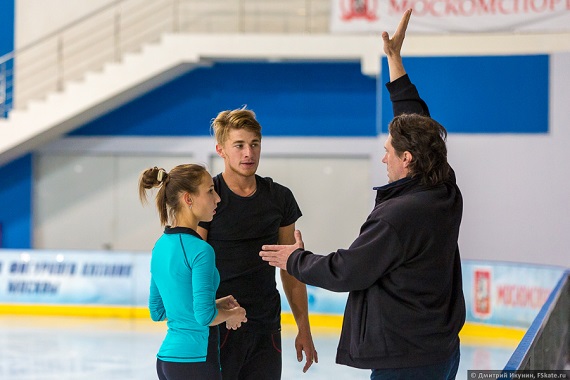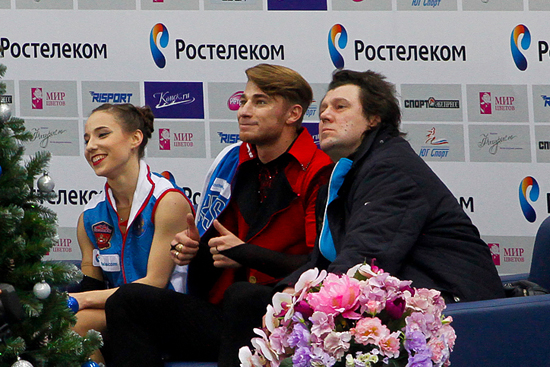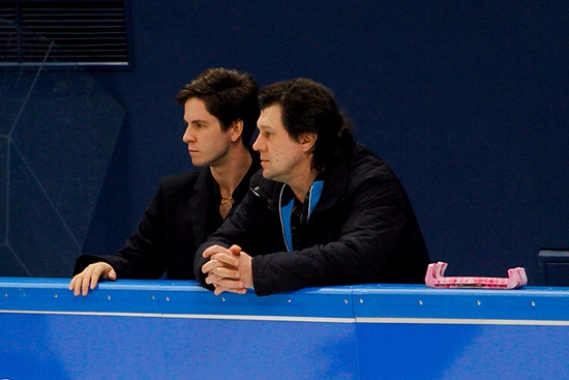Artur Dmitriev: the progress can’t be stopped
Artur Dmitriev told about how Kristina Astakhova / Alexei Rogonov prepare for the new season and expressed his thoughts on the prospects of development of the pair skating.
Artur, you have repeated many times that it’s necessary at least three years to create a pair. From this point of view, how will be the new season for your students Kristina Astakhova / Alexei Rogonov?
Artur: Over the past two seasons the guys become a pair. Now they can do confidently pair elements – death spiral, lifts, jumps, spins, steps … Last season was good. At the beginning I told them that second year won’t be easy. At first, they haven’t really thought about my words, and when the work started, they came across with this themself. It’s like a tightrope walker in circus. The first time he walked on a tightrope without thinking, and then once: oh, high! But it happens to everyone and in everything. As a coach I know this issue and I know the answer.

Over the past months we have worked a lot on jumps. We try combination 3 – 3 – toe loop – half loop – salchow. We learned triple loop, it wasn’t so easy for Alexei, who’s 27 years old. We work on the quad throws – loop and flip. We try both. We’ll insert new jumps into the programs, throws – will see. We likely will try to do them, depending on how the work will go, but not at every competitions. It’s one thing to perform an element at training, and quite another – in the program at competitions. These are completely different things.
So, the task Astakhova / Rogonov are facing, we’ll solve gradually. My job as a coach to bring a pair to another level of quality in the upcoming season. I couldn’t do that before because there wasn’t full understanding. In such thing as pairs skating only desire is not enough, we need to realize that this is necessary, we ready for this. When this appears, you can take the next step. I often say that the fruit must ripen. If you pick a green apple, you won’t eat it because it’s unripe.

Agree.
Artur: Now the guys are ready, and I can lead them further. There is a tricky point – they feel it too. During these two years, they’ve became a pair, and now less energy is spent on the execution of elements – death spirals, lifts, steps sequences … Thus, more energy for expressiveness, skating skills … We work a lot on skating skills, plus new elements.
Both programs are ready. Short program turned out wider, with more freedom. Kristina is more visible in it, because the program was put mainly on her. In the short program we changed a jump to a triple loop. The rest remains familiar for the guys.
Free program is more complicated. But, as I said, all the changes we will make gradually. Will see how it go: pressed – released. Guys won’t perform their old jumps. We’ll go on complication way. Triple loop instead of triple salchow combination 3-3 instead of 3-2-2. Even if somewhere they will do a 3-2, it still means that we strive to two triples. We got the opportunity for variations, we will try. In addition, free program hasn’t changed so much – we did a sequel, the second part of “Doll”.

You probably watched the pair competitions at the World Championships in Boston. What did you point out for yourself?
Artur: Pair skating has complicated. Maybe after some time we will see a different picture, because our discipline developes in waves. It is unknown what will happen after the current leaders leave. But at this stage the progress can’t be stopped.
Yes, Canadians Duhamel – Radford lack expression, culture and quality of movement, but they are doing a side by side triple lutz and a quadruple throw.
Chinese Wenjing Sui – Cong Han made mistakes at the World Championships. But at the same time I would point out that the pair miraculously came from the juniors, and those elements which they showed then will continue to develop and programs will become more complicated.
As for Aliona Savchenko – Bruno Massot, I have great respect for Aliona, but still think that German pair was very well supported by the judges in Boston. I say this not as a coach of Russian pairs, but as a professional. I’m very glad that in a short period of time these guys have done a great job, but is it possible to compare them with our Stolbova and Klimov? Ksenia and Feodor objectively skate better. Skating of German pair at the World Championships looked somewhat primitive, it was simple. Agree that from Aliona – multiple world champion, skater that has been at four Olympics, everyone is waiting quite another – a quadruple twist, and apparently it’s not far off, quadruple throw. But they didn’t managed to put everything together and show it at the World Championships. So why such high scores?
After Boston it became obvious for me that in today’s figure skating there can’t be random pairs. The level of elements have complicated so much that “random people” who appeared out of nowhere – six months and the pair is ready – this is not going to happen. It takes time, years, to learn everything, earn, fold together. And in order to stay ahead of rivals, you need to have the technical margin, which would allow not to miss a new qualitative leap. The leap we see today.
What happened in single skating? If before we could count on the fingers skaters who do quad and the Olympic Games in Vancouver Lysacek won without quad jump, now a lot of guys are doing a quad and not one, but several in program.
The same thing happens in pairs. Our two-time Olympic champions Tatiana Volosozhar – Maxim Trankov at the Olympic Games in Sochi have been out of reach, and now they don’t skate worse. They still skate great as it was then. But while they haven’t competed others have gone further. In this sense, it’ll be very difficult for Tatiana and Maxim. But how to stop the ongoing process? Tell: don’t do a quad throw, twist, 3-3 combinations? But it’s like to forbid men do quad jumps, or forbid girls to a jump with three and a half turns. Suggest – skate beautifully! But then figure skating as a sport will become a model business.
Another question that there should be a reasonable approach to learning such difficult elements, because untrained athletes could get serious injuries. In such a complicated case you can’t attack, if not ready. The attack must be technically prepared. There must be understanding, a clear knowledge, certain developments …Alexei Mishin has worked for many years on his technique, a system of multi-turn jump training, and now whole world uses it. The same should happen in pair skating.
You won at two Olympics, from the height of your experience what advice can you give to award-winning athletes, who continue to skate. Where to find the motivation?
Artur: The answer is simple. Fortunately, the former achievements in sports are not considered, in the sense that everything is in the past. And if you want to continue, then you need to work. It all depends on the person, on his desire, goals.
the source: fsrussia.ru
Related topics: aliona savchenko bruno massot, Artur Dmitriev, Kristina Astakhova Alexei Rogonov, Ksenia Stolbova Fedor Klimov, Meagan Duhamel Eric Radford, pairs, Tatiana Volosozhar Maxim Trankov, Wenjing Sui Cong Han

Leave a Reply